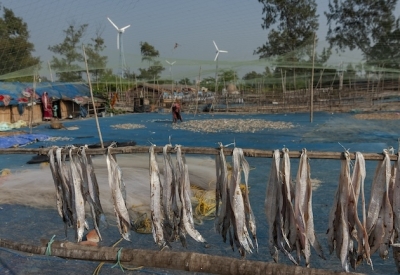At the current rate of investment, more than 340 million women and girls will still live in extreme poverty by 2030, according to UN Women. As the world celebrates International Women’s Dayon 8 March by investing in women, we look at what needs to be done to improve the economic situation of women around the world.
“This year’s theme – invest in women – reminds us that ending the patriarchy requires money on the table,” UN Secretary-General António Guterres said in a statement for the International Day.
“This all depends on unlocking finance for sustainable development so that countries have funds available to invest in women and girls,” he said, calling for action to support programmes to end violence against women and to drive women’s inclusion and leadership in economies, digital technologies, peacebuilding and climate action.
Right now, the world needs an additional $360 billion per year for developing countries to address gender equality under the Sustainable Development Goals (SDGs) of the 2030 Agenda for Sustainable Development.
While increasing women’s share of assets and finance is vital for their economic empowerment, equally important is building institutions that promote public investment in social goods and sustainable development.
Here are five things guaranteed to accelerate women’s economic empowerment:
1. Resources: Ramp it up
Connecting women with financial resources can help them meet their basic needs and start or grow businesses, but micro, small, and medium-sized female-owned businesses are underfunded by $1.7 trillion. Closing the credit gap for women owned small and medium enterprises would result in a 12 per cent increase in annual incomes on average by 2030.
In addition, women need access to land, information, technology and natural resources. In 2022, 2.7 billion people still lacked internet access, which is fundamental for getting a job or starting a business.
Despite the fact that more than one third of working women are employed in agricultural industries, they are also less likely than men to own or have secure rights for agricultural land in 87 per cent of countries where data is available.
When women do have equal rights to access, own and use resources, they can invest in themselves by improving their wellbeing, education, starting a business or exercising agency over their income to build a society that works for them.
For example, in many contexts women’s economic empowerment reduces gender-based violence, increases political and social participation and leadership and facilitates disaster risk reduction.
2. Wanted: Jobs
When women thrive in the world of work, they are better positioned to exercise their agency and realize their rights, but not just any job will do. Work must be productive and in conditions of freedom, equity, security and dignity.
Nearly 60 per cent of women’s employment globally is in the informal economy, and in low-income countries, it is more than 90 per cent. Even when women do have jobs, they are paid on average 80 cents for every dollar earned by men and even less for some, including women of colour and mothers.
Gender inequality in earnings alone costs the world more than twice the value of global GDP in terms of human capital wealth.
Measures such as pay transparency, equal pay for work of equal value and access to care services can help close the gender pay gaps in pay leading to gender equality in the workplace. When women entrepreneurs are successful, they can create jobs and drive innovation.
The world could see a 20 per cent increase in GDP by closing gender gaps in employment.
3. Time: Finding work-life balances
Everyone requires care in their lifetime. The existing social organization of care reflects profound inequalities of status and power and often exploits the labour of women and girls. On average, women spend around three times more time on unpaid care and domestic work than men.
The gendered disparities in unpaid care work are a profound driver of inequality, restricting women’s and girls’ time and opportunities for education, decent paid work, public life, rest and leisure.
Care work remains undervalued and underpaid. The monetary value of women’s unpaid care work globally is at least $10.8 trillion annually, three times the size of the world’s tech industry.
Investing to transform care systems is a triple win: it allows women to reclaim their time while creating jobs in the care sector and increasing access to care services for those that need them.
It is estimated that closing existing gaps in care services and expanding decent work programmes would create almost 300 million jobs by 2035.
4. Calling for security
Women face numerous threats to their security, including gender-based violence, conflict, food insecurity and a lack of social protection. Violence at home or in the workplace is a violation of women’s rights and impedes their economic participation.
The global cost of violence against women is estimated to be at least $1.5 trillion or approximately two per cent of global gross domestic product.
The number of women and girls living in conflict-affected countries reached 614 million in 2022, 50 per cent higher than the number in 2017. Such crises can exacerbate pre-existing economic disparities, such as women’s disproportionate share of unpaid care work. Crises also deepen inequalities among women; for example, migrant women are twice as likely to experience violence than non-migrants.
Research suggests gender-responsive social protection systems like cash transfers can reduce mortality rates among women, demonstrating the links between economic empowerment and security.
No matter what form it takes, insecurity hinders women’s economic empowerment, traps them in poverty, and prevents them from realizing their rights and potential. It is critical to bring together diverse stakeholders, including in the private sector, and challenge social norms that value women as inferior to men as economic actors.

5. Protecting rights
Human rights are at the core of women’s economic empowerment. Unjust, patriarchal economic systems perpetuate gender inequality, and discriminatory social norms stand in the way of women’s access to information, networks, jobs and assets.
Globally, on average, women have only 64 per cent of the legal rights enjoyed by men. Key strategies to promote women’s rights in the context of economic empowerment include adoption of laws and policies that support women’s economic empowerment and repeal of discriminatory laws and legal frameworks.
While acknowledging the intrinsic value of women’s economic empowerment, which has human rights at its core, it is also important to account for the great costs of constraints on women’s economic empowerment on societies and economies.
The protection and support for women human rights defenders and accountability for human rights abuses are needed. This requires documenting women’s rights abuses, collecting sex disaggregated data and developing partnerships for joint advocacy programmes.
It is necessary to develop and implement accountability mechanisms to protect women’s rights and ensure that women’s voices are amplified in all spaces of decision making.
Learn more about how the UN is helping women around the world here.






